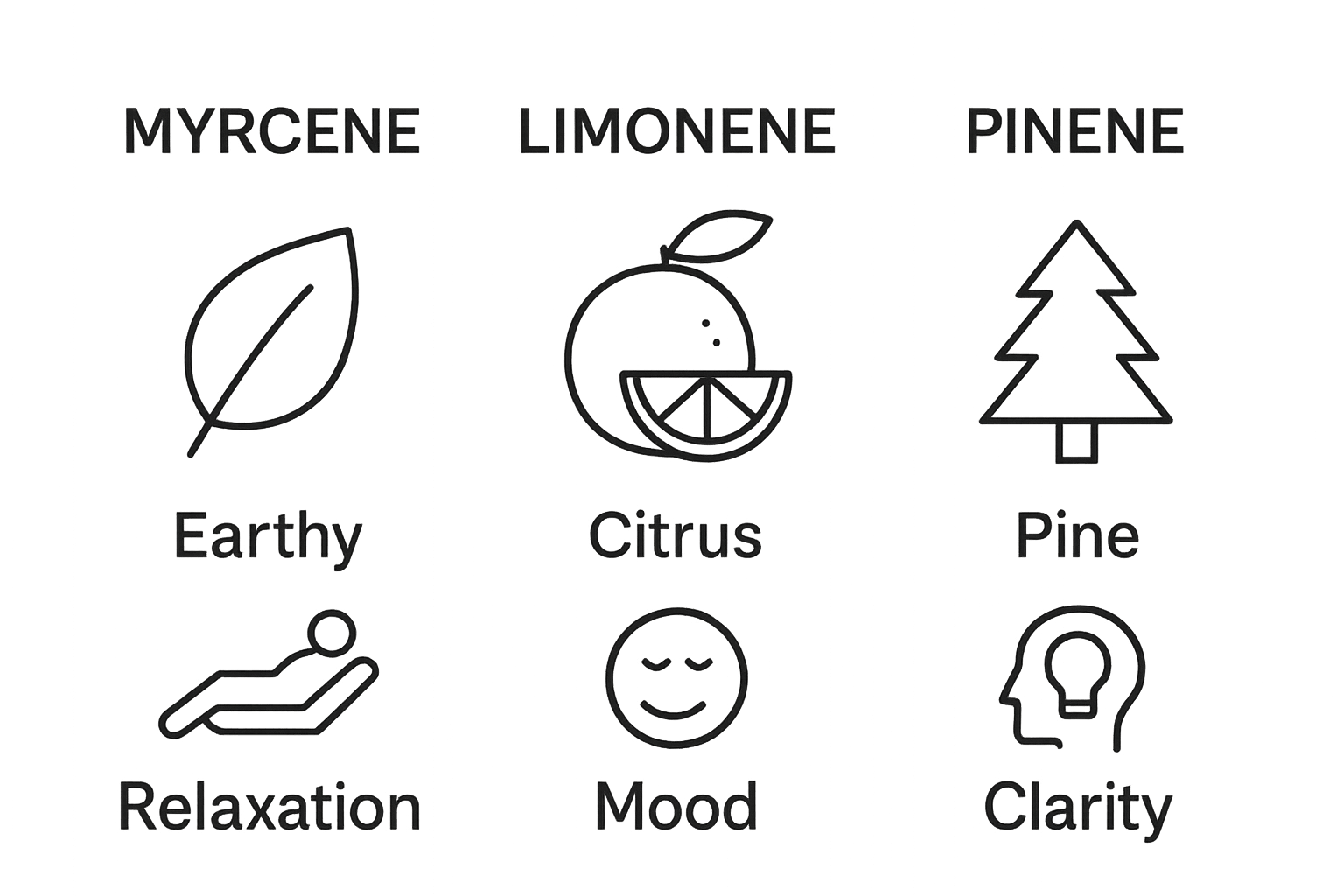Understanding Terpenes in Hemp Flower: Their Role & Benefits
Written by California Blendz

Terpenes shape the very first thing you notice about hemp flower. These tiny molecules are behind every unique scent and flavor you experience, and they do so much more than smell nice. Some research shows that over 200 different terpenes can be found in cannabis, each one able to interact with your body in surprising ways. Most people think it’s just about the aroma, but recent studies point toward terpenes playing a major role in how hemp makes you feel and even how well it works.
Table of Contents
- What Are Terpenes And Their Importance In Hemp Flower?
- The Role Of Terpenes In Hemp Flower’s Aroma And Flavor
- How Terpenes Interact With Cannabinoids In Hemp Flower
- Terpenes And Their Potential Health Benefits
- Real-World Applications Of Terpenes In Hemp Flower Products
Quick Summary
| Takeaway | Explanation |
|---|---|
| Terpenes determine aroma and flavor. | Terpenes create unique scents and taste profiles in hemp flower, influencing consumer preferences and experiences. |
| Synergistic effects with cannabinoids. | Terpenes enhance or modify cannabinoid effects, potentially improving therapeutic outcomes through the entourage effect. |
| Targeted health benefits from individual terpenes. | Specific terpenes like limonene and myrcene offer potential mood regulation and relaxation, making them valuable for wellness products. |
| Terpene profiles can be engineered. | Manufacturers can create unique hemp flower products by strategically developing terpene profiles for desired sensory and therapeutic effects. |
| Terpenes can support mental and physical health. | Many terpenes exhibit properties that may help with stress, anxiety, and inflammation, highlighting their wellness potential. |
What Are Terpenes and Their Importance in Hemp Flower?
Terpenes are aromatic organic compounds found naturally in hemp and other plants, responsible for creating distinctive scents and potentially contributing to therapeutic effects. These complex molecules play a crucial role in determining the sensory experience and potential wellness benefits of hemp flower.
The Chemical Composition of Terpenes
At their core, terpenes are hydrocarbon compounds composed of repeating isoprene units. In hemp flower, these molecules are produced in the plant’s trichomes microscopic resin glands that cover the surface of hemp flowers and leaves. Research from the National Center for Biotechnology Information indicates that terpenes contribute significantly to the plant’s unique chemical profile.
Key characteristics of terpenes include:
- Highly volatile organic compounds
- Responsible for distinctive plant aromas
- Can interact with human bodily systems
- Vary in concentration based on plant genetics and growing conditions
Therapeutic Potential and Interaction with Cannabinoids
Terpenes are not just about fragrance they potentially work synergistically with cannabinoids in a phenomenon known as the “entourage effect.” This interaction suggests that terpenes might enhance or modulate the effects of cannabinoids like CBD and THC. Check out our comprehensive guide on terpene benefits to understand how these compounds might contribute to your wellness journey.
In hemp flower, different terpene profiles can create unique experiences ranging from relaxation to potential mood enhancement. Some common terpenes like myrcene, limonene, and pinene each bring distinct characteristics that contribute to the overall sensory and potential therapeutic experience of hemp products.
The Role of Terpenes in Hemp Flower’s Aroma and Flavor
Terpenes are the primary architects of hemp flower’s sensory landscape, creating complex and nuanced aromatic profiles that distinguish different hemp varieties. These volatile organic compounds are responsible for the rich, multilayered scents and flavors that make each hemp strain unique.
The Science of Aromatic Complexity
Terpenes function as nature’s perfume engineers, generating distinctive scents through intricate molecular structures. Research from Purdue University’s Agricultural Extension reveals that different terpene combinations produce dramatically varied aromatic signatures ranging from earthy and woody to citrusy and floral.
Key characteristics of terpene aromatic profiles include:
- Molecular volatility that allows rapid scent dispersion
- Genetic variation influencing specific aromatic compounds
- Environmental factors affecting terpene production
- Unique interaction patterns between different terpene molecules
Flavor and Sensory Experience
Beyond aroma, terpenes significantly contribute to the overall flavor experience of hemp flower. Each terpene brings its own gustatory signature, creating a complex taste profile that goes far beyond simple sweetness or bitterness.
The following table summarizes some of the most common terpenes found in hemp flower and highlights their main aromas and potential health benefits.
| Terpene | Primary Aroma | Potential Health Benefits |
|---|---|---|
| Myrcene | Earthy, musky | Relaxation, sleep support |
| Limonene | Citrus | Mood elevation, stress reduction |
| Pinene | Pine | Alertness, counteracts THC effects |
| Linalool | Floral, lavender | Anxiety reduction, calming |
| Beta-caryophyllene | Spicy, peppery | Anti-inflammatory, pain management |
| Explore our comprehensive guide on terpene types and their unique characteristics to understand the intricate world of hemp flower flavors. |
Common terpenes like limonene deliver bright citrus notes, while myrcene introduces earthy undertones. Pinene contributes sharp, pine-like flavors, and these molecular variations create the rich sensory tapestry that makes each hemp flower strain a unique gustatory experience.

How Terpenes Interact with Cannabinoids in Hemp Flower
The interaction between terpenes and cannabinoids represents a complex biochemical dance that significantly influences the overall therapeutic and sensory experience of hemp flower. This phenomenon, known as the “entourage effect,” suggests that these compounds work synergistically to produce more nuanced and potentially enhanced effects.
The Entourage Effect: Molecular Collaboration
Research from the National Institutes of Health demonstrates that terpenes can fundamentally alter how cannabinoids interact with the human body. These organic compounds do not merely provide aromatic characteristics but actively modulate the physiological responses triggered by cannabinoids like CBD and THC.
The table below outlines key mechanisms by which terpenes can interact with cannabinoids and the human body, supporting the concept of the entourage effect in hemp flower.
| Mechanism | Description |
|---|---|
| Modifying cannabinoid receptor binding affinity | Terpenes can change how cannabinoids bind to receptors |
| Influencing neurotransmitter pathways | Terpenes may impact chemical messaging in the brain |
| Altering absorption rates | Some terpenes can increase or decrease cannabinoid uptake |
| Modulating physiological responses | Terpenes can enhance or offset effects of cannabinoids |
Key mechanisms of terpene interaction include:
- Modifying cannabinoid receptor binding affinity
- Influencing neurotransmitter signaling pathways
- Potentially reducing or enhancing cannabinoid absorption
- Contributing to overall physiological responses
Biological Pathways and Receptor Interactions
Terpenes engage with the human body through multiple sophisticated biological mechanisms. Some terpenes can directly interact with cannabinoid receptors, while others might influence neurotransmitter systems or cell membrane permeability. Learn more about the intricate science behind cannabis compounds to understand these complex interactions.
For instance, myrcene might increase cell membrane permeability, potentially allowing faster cannabinoid absorption. Pinene could counteract some THC effects by inhibiting certain enzyme activities, demonstrating the nuanced and intricate nature of these molecular interactions within hemp flower.
Terpenes and Their Potential Health Benefits
Terpenes extend far beyond aromatic compounds, emerging as promising candidates for potential therapeutic interventions. These molecular structures found in hemp flower demonstrate complex interactions with human biological systems, suggesting nuanced health and wellness applications.
Targeted Physiological Interactions
Research from the National Institutes of Health reveals that specific terpenes exhibit remarkable potential for addressing various physiological challenges. Different terpenes interact with human systems through multiple mechanisms, potentially offering targeted support for wellness and management of specific health conditions.
Key potential therapeutic domains of terpenes include:
- Potential anti inflammatory responses
- Possible mood regulation mechanisms
- Natural stress and anxiety management
- Supporting neurological function
- Potential pain perception modulation
Individual Terpene Health Profiles
Each terpene presents a unique profile of potential health benefits. Limonene might offer mood elevation and stress reduction, while myrcene could provide potential relaxation and sleep support. Beta caryophyllene demonstrates promise in addressing inflammation, and linalool might contribute to anxiety reduction. Explore our comprehensive guide on terpene characteristics to understand these intricate molecular interactions.
While research continues to unveil the complex potential of terpenes, early scientific investigations suggest these compounds represent a fascinating frontier in understanding natural wellness approaches. The subtle yet profound interactions between terpenes and human biological systems continue to intrigue researchers and wellness enthusiasts alike.

Real-World Applications of Terpenes in Hemp Flower Products
Terpenes have transitioned from scientific curiosity to practical applications across multiple wellness and consumer product domains. Their versatility allows manufacturers and consumers to leverage these compounds for enhanced sensory experiences and potential therapeutic outcomes.
Product Formulation and Enhancement
Agricultural research from the University of Florida highlights the growing importance of terpenes in product development. Manufacturers now strategically incorporate specific terpene profiles to create targeted hemp flower products with distinctive characteristics and potential wellness benefits.
Key application areas for terpene integration include:
- Customized hemp flower strain development
- Precise flavor and aroma profile engineering
- Wellness product targeted experiences
- Natural preservation and stabilization techniques
- Advanced extraction and concentration methods
Diverse Consumer Product Innovations
Terpenes are revolutionizing product experiences across multiple categories. Hemp flower extracts now feature carefully curated terpene profiles in products ranging from relaxation tinctures to mood management supplements. Learn more about our comprehensive terpene guide to understand these sophisticated molecular applications.
Innovative applications include developing products with specific intended experiences like energy enhancement, stress reduction, or sleep support. Manufacturers are increasingly using terpene science to create more nuanced and personalized hemp flower experiences that go beyond traditional cannabinoid focused approaches.
Experience Terpene Excellence with California Blendz
Are you still searching for truly potent hemp flower strains that deliver the nuanced terpene profiles and benefits discussed in our article? Many shoppers find it challenging to identify authentic, high-quality hemp products where terpene synergy is maximized for relaxation, mood, or relief. The truth is that not all hemp is created equal and your experience with aroma, flavor, and effect depends on the precise terpenes within each flower. Discovering products that stay true to the science of terpenes can deeply enhance your wellness routine. Explore our premium The Founder’s Collection, where every curated strain is lab-tested for terpene content and sourced for sustainable purity.

Make your next purchase your best one yet. Visit California Blendz for the most trusted hemp flower, shop handpicked THCa favorites in the THCa Prestige Vault, or take advantage of the freshest New Deals. Discover the difference that real terpene transparency and quality can make. Act now to elevate your hemp journey with strains designed for a personalized sensory and therapeutic experience.
Frequently Asked Questions
What are terpenes in hemp flower?
Terpenes are aromatic organic compounds found in hemp and other plants, responsible for the unique scents and potential therapeutic effects of hemp flower. They are produced in the plant’s trichomes and contribute significantly to the plant’s chemical profile.
How do terpenes enhance the effects of cannabinoids?
Terpenes potentially work synergistically with cannabinoids in a phenomenon known as the “entourage effect,” where they can enhance or modulate the effects of cannabinoids like CBD and THC, leading to a more personalized wellness experience.
What are some common types of terpenes found in hemp flower?
Common terpenes include myrcene, which may provide relaxation, limonene, known for its citrus aroma and potential mood enhancement, and pinene, which can offer pine-like flavors and may counteract some effects of THC.
What potential health benefits do terpenes offer?
Terpenes may provide various health benefits, such as anti-inflammatory effects, mood regulation, stress relief, and support for neurological function. Each terpene has its unique profile that may address specific physiological challenges.








